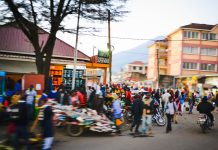African leaders are working on a free-trade agreement that will cover a whole continent. Talks to establish the African Continental Free Trade Area started in 2015 and while many signatures of the 55-member African Union are still outstanding, Ghana and Kenya on May 10 became the first countries to ratify the deal. Supporters dream that every nation on the continent will eventually join and create a trade bloc with a combined gross domestic product of more than $3 trillion.
1. What’s the African Continental Free Trade Area?
It’s a project driven by the AU to eliminate tariffs on intra-Africa trade of goods and services and create a single continental market with free movement of business people. Intra-Africa trade currently stands at about 16 percent of the continent’s total, compared with 19 percent in Latin America and 51 percent in Asia. The agreement could increase this by half, the United Nations Economic Commission for Africa estimates. Joined together, the continent’s combined GDP would be almost the size of the Germany’s, which would give Africans a stronger voice in global trade negotiations, according to AU Commission Chairperson Moussa Faki Mahamat.
2. What would the trade agreement do?
Once implemented, the agreement would remove tariffs on 90 percent of goods. It will also pave the way for the establishment of a continental customs union.
3. Are there any free-trade agreements in Africa?
Yes, there are at least eight decades-old trade communities on the continent. While these are mostly grouped according to region, some countries belong to more than one bloc, creating overlap. The AfCFTA won’t immediately replace these regional blocs but rather harmonize the standards and rules to ease trade between the groups and eventually the smaller groupings will be consolidated under the continent-wide agreement.
4. What’s been the hold-up?
Back in 2015, trade ministers said talks about the free trade area would conclude by the end of 2017, but slow progress in negotiations on tariff schedules and the rules of origin of manufactured goods and a lack of political will in some countries have dragged out the process.
5. Who has signed this deal?
More than three quarters of all African nations — 44 countries — signed the AfCFTA agreement at a meeting of the heads of state in March in the Rwandan capital, Kigali. It will only become effective once the parliaments of at least 22 members ratifies it.
6. Who hasn’t signed up?
The continent’s two biggest economies. Nigerian President Muhammadu Buhari canceled his trip to Kigali for the signing at the 11th hour. Some critics said Buhari bowed to pressure from labor unions, who are concerned that the free-trade area would open up Nigeria to dumping of cheap products and cause job losses if the demand for locally produced goods fall. Buhari has to be mindful of public opinion since it’s less than ten months before the next elections, in which he intends to seek a second term in office. South Africa, the continent’s most-industrialized economy, has also not yet signed the agreement. President Cyril Ramaphosa did sign the Kigali Declaration, which supports the establishment of the bloc, but said the country will only become a signatory to the agreement once parliament approves it.
7. What about the other hold-outs?
Botswana, Lesotho and Namibia are some of the other countries that haven’t signed up. They are part of the Southern African Customs Union with South Africa, making it difficult for them to agree to free-trade terms if their biggest customs partner haven’t done so yet.
8. Who could benefit most?
Countries such as South Africa and Kenya with larger manufacturing bases and better road networks, railways and ports are most likely to benefit from further regional integration, according to Moody’s Investors Service. For others, poor infrastructure and non-tariff barriers, such as cumbersome government regulations, will continue to restrict the trade sector’s development and long-term growth potential.
9. What are the next steps?
The target is to establish the free-trade area by 2020, almost a decade after the AU first agreed to pursue the vision, but it could take longer than that. Even the Tripartite Free Trade Area, precursor of the AfCFTA which will combine the Common Market for East and Southern Africa, the East African Community and the Southern African Development Community and was signed almost three years ago, hasn’t become effective yet. Member countries must now develop and submit their positions on which products’ trade should be liberalized. Protocols on investment, competition and intellectual property are also still to be negotiated and member countries must meet to adopt the structure and of the AfCFTA secretariat, the staff rules and regulations, and its budget.
SOURCE: Bloomberg






































